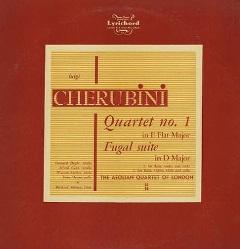Cherubini – Quartet No.1; Fugal Suite
Cherubini – Quartet No.1; Fugal Suite

Quartet No 1 in E flat major 1 Adagio - allegro agitato 2 Larghetto sans lenteur 3 Scherzo- allegro moderato 4 Allegro assai Fugal suite, in D major 5 Allegro 6 Andante con moto, quasi alle breve lento Aeolian Quartet of London Leonard Dight, Alfred Cave - violins Watson Forbes - viola JOhn Moore - cello Richard Adeney – flute (5,6)
String Quartet No.1. A cantabile Adagio introduction in 3/4 time establishes a warm atmosphere for the first movement, but this placidity soon gives way to the livelier Allegro agitato. The first theme consists of ascending phrases, scattered muttering, and repeated pauses. This builds into steadier, driving material that leads to the second subject, a pressing yet singing line for the first violin that alternates with quick exchanges among the other instruments. (Cherubini was influenced by the quatour brillante style of Viotti, Spohr, and others, in which the string quartet was a miniature concerto for first violin.) The exposition's pressing coda presents a third element for Cherubini to manipulate in the development section, which compresses the themes and to a large extent strips away their differences, creating a long, steady pulse of energy. A loud fugato section seems to drain the music of its tension, at least in the succeeding bars; a gradual revving-up leads to the recapitulation, which presents the themes in their original forms.
The second movement, strangely and bilingually marked Larghetto sans lenteur, is a series of variations on a long, eighteenth-century-style theme that proceeds in a series of hops and skips that seem courtly and ceremonial rather than playful. The cello remains silent in the first variation, and here the melody does become more frolicsome. The second variation is more dramatic, the now-returned cello occasionally making forceful, chromatic outbursts. The third variation is far more intimate, slow, and almost religious. The final variation is the most exuberant of all, the first violin's initial four notes identical to those of the later Happy Birthday song. The coda, in contrast, returns the movement to its opening mood.
Third comes a scherzo marked Allegretto moderato, a fairly quick yet still oddly melancholy dance with the violins playing a tune over an accompaniment that simultaneously rocks and drones. This periodically breaks into more excited material. The Trio section is fleet and scampering in the manner that would soon become associated with Mendelssohn.
The fourth movement is a rondo, Allegro assai. A short, gruff opening leads to an instrumental sprint with the first violin almost always in the lead. After an exchange between the first violin and cello over a twittering accompaniment (the stuff of comic opera), the primary rondo theme returns with a slightly more dramatic elaboration of the theme's second half. Next is essentially a rehash of the first section, now unchanged except for its key, then the runs that initially dashed away from the introduction, and a scintillating coda. ---James Reel, Rovi
download: uploaded anonfiles yandex 4shared solidfiles mediafire mega filecloudio








